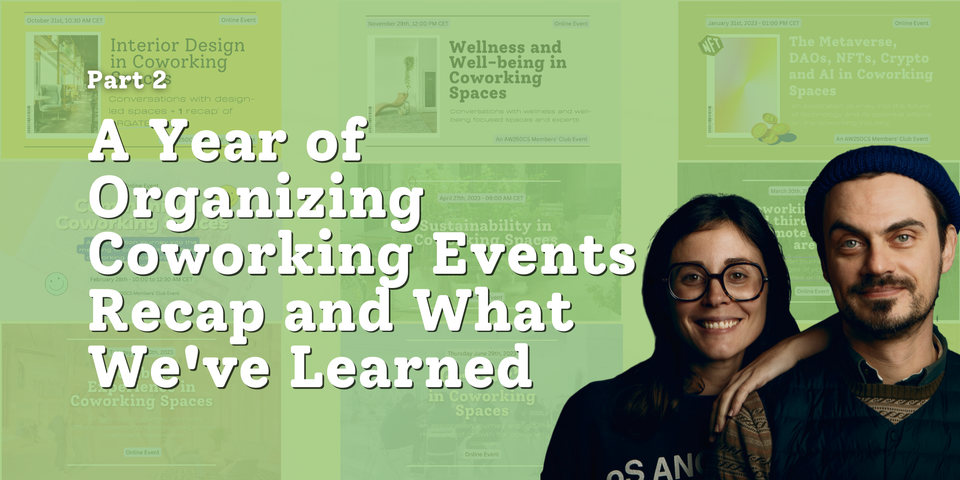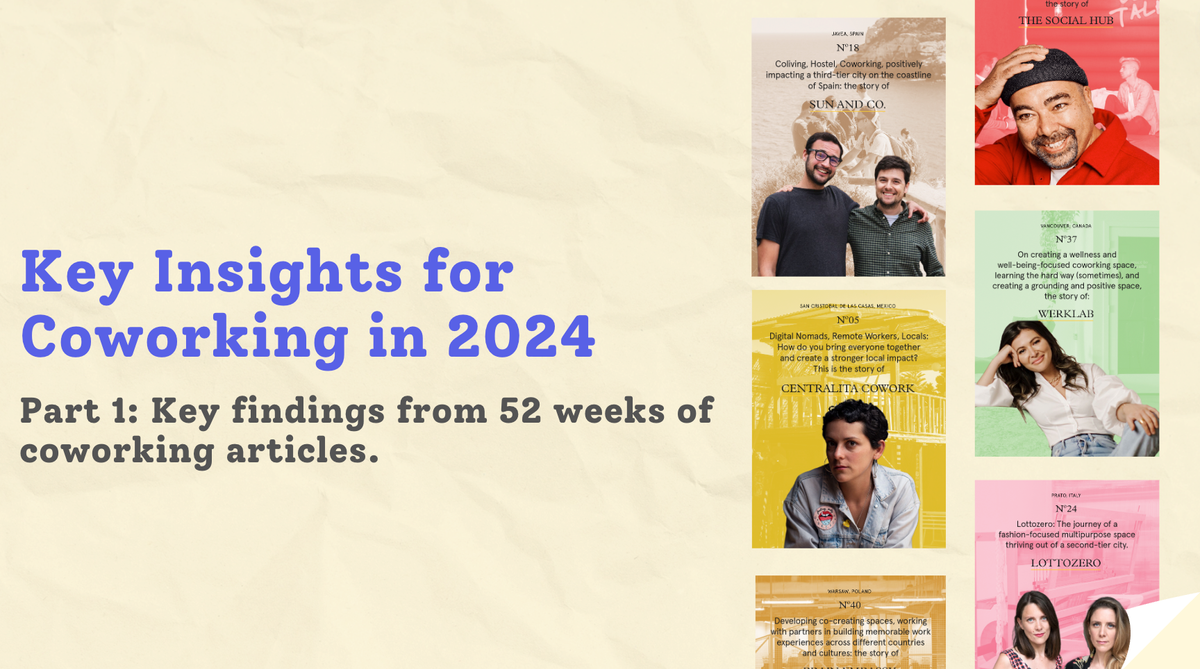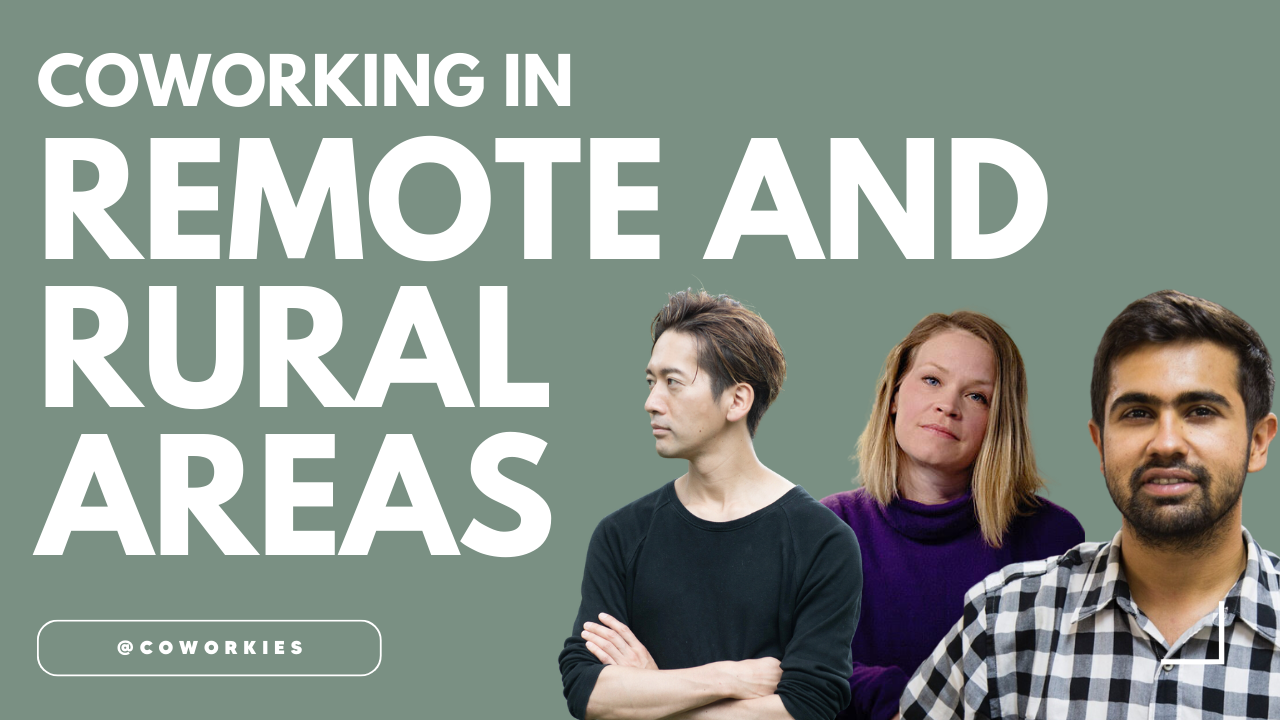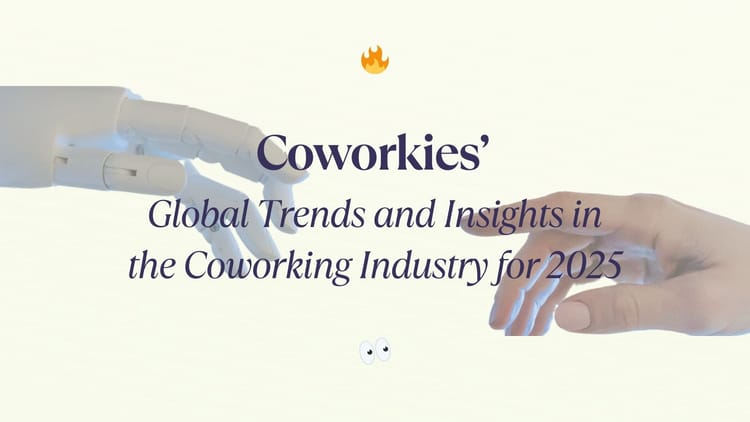A Year of Organizing Coworking Events - Recap and What We've Learned

Discover our Key Takeaways from Organizing 9 Coworking Events with Industry Experts on Essential Business Topics Last Year as Part of the Digital52 Coworking Series
Welcome to the second installment of our exploration into trends and topics shaping coworking trends for 2024. If you haven't yet had the chance to read Part 1, 'Essential Insights for Coworking in 2024: 10 Key Findings from Digital52 Coworking Series' we encourage you to start there for overview insights into the coworking landscape of 2024 with emphasis on what teams should focus on.

Part 1, was all about the vast amount of knowledge gathered from our Digital52 coworking series, where we took 52 stories from our book “Around the World in 250 Coworking Spaces”, and expanded them with extra content and post-book publication interviews to understand how some of the coworking spaces featured in the book evolved overtime and overcame the many challenges surrounding their operations.
This article outlines the key insights we’ve gathered from hosting the topical monthly events at Coworkies TV. But remember, each one is just a piece of the bigger coworking picture. As we like to say “Coworking is the Same Dish, Everyone Cooks Differently”. Every coworking space has its way of doing things. In the article below we outline the key points made at our recap event Key Coworking Insights for 2024. More importantly, we point to specific stories from Digital52 Events to help make sense of these insights. And as you read, we hope you'll find fresh ideas for the upcoming year and maybe even see coworking in a new light.
💺 Key Insight 01: Interior Design in Coworking Spaces

Interior design within coworking spaces is evolving to become a direct reflection of the environment and the members' requirements. A standout trend in workspace interiors has been the shift towards flexible furniture tailored for multifunctional spaces. As we’ve observed during our visit to events like Orgatec, manufacturers are increasingly designing furniture that is adaptive, maneuverable, and suited for diverse professional needs. In one word - Flexible. These furniture design shifts have been driven by the rise of coworking and flexible workspaces, rapidly accelerated by the challenges posed by the COVID-19 pandemic. With the influx of professionals accustomed to traditional office setups into coworking spaces, there's a noticeable demand for furniture that offers privacy, security, and flexibility. On the other hand, during the pandemic, workers became accustomed to more relaxed furniture styles. Therefore, integrating traditional office furnishings with softer seating options is worth considering, as it can provide maximum comfort and create a 'homey' atmosphere in the workplace.
While architectural advice play a pivotal role in the creation of modern flexible workspaces, the type of furniture used significantly influences the vibe and utility of the space.
Though high-quality furniture often comes with a heftier price tag, there are alternatives like refurbished or self-made pieces that can add character and charm, appealing to a different segment of coworkers.
Additionally, the industry has seen the emergence of services that offer furniture rentals, allowing spaces to maintain flexibility in design without a substantial upfront investment. This model enables coworking founders to budget effectively and adapt to the changing needs of their members.
These insights, drawn from conversations with industry experts such as Sombat Ngamchalermsak of Paperwork in Bangkok (Thailand 🇹🇭), Marlies Bloemendaal of Ministry of New in Mumbai (India 🇮🇳), and Joana Carvalho from Dinamo10 in Viana do Castelo (Portugal 🇵🇹), underscore the importance of adaptability and thoughtful design in today's coworking spaces. Based on their backgrounds ranging from architecture to creative direction, they have highlighted the need for spaces that are not only aesthetically pleasing but also functional, modular, and responsive to the ever-changing demands of the post-pandemic world.
You can rewatch again the different interviews from our event “Interior Design in Coworking Spaces” on CoworkiesTV below.
🧘♀️ Key Insight 02: Wellness and Wellbeing in Coworking Spaces

Gone are the days when wellness was synonymous with the occasional yoga class. Today's coworking spaces are embracing a more comprehensive approach, focusing on the complete well-being of their community. As highlighted during our event on the topic, which brought together industry experts such as David O’Coimin from Nook Pods in Amsterdam (The Netherlands 🇳🇱), Vibushan Thirukumar from Oru Space in London (UK 🇬🇧), Anouska Shenn from The Office Yoga Company in London (UK 🇬🇧), and Christina Disler from Werklab in Vancouver (Canada 🇨🇦), there's a growing understanding that wellness isn't just about offering yoga classes. It's about creating an environment that holistically nurtures the wellness and well-being of coworking members.
"Wellness isn't just about offering yoga classes. It's about creating an environment that holistically nurtures the wellness and well-being of coworking members."
Central to this approach are four key components: purpose, interior design, inclusivity, and programming.
- The "purpose" entails establishing a clear vision for incorporating wellness and well-being elements.
- Interior design plays a crucial role in affecting users' mental and emotional states. For instance, ambient customization, as seen in Nook's flexible pods, can cater to the specific needs and preferences of users.
- Inclusivity, as emphasized by David, revolves around designing spaces that cater to a diverse spectrum of users, considering factors like light sensitivity or noise preferences.
- Lastly, programming incorporates not just physical activities like yoga but a comprehensive approach to wellness, including dietary and mental health programs.
A standout example is Oru Space in London, which has seamlessly integrated wellness into its offerings. Vibushan from Oru Space has emphasized the importance of mindful food choices, with the coworking space's cafe and restaurant menus designed to promote wellness, ensuring members feel energized and productive throughout the day.
In essence, a modern coworking space's "wellness mix" goes beyond physical amenities to include programs and design elements that foster both physical and mental well-being. As coworking spaces evolve, it's evident that a comprehensive approach to wellness and wellbeing is not just an added perk but a foundational element that defines the very essence of these types of spaces.
You can watch again the recorded interviews from our event “Wellness and Well-being in Coworking Spaces” on CoworkiesTV below.

Get a Reader Membership
Greetings from "Coworkies Club"! Over the past year, we've invested over 1,000 hours in curating coworking stories and fostering community events. Your support—whether by purchasing our book "Around the World in 250 Coworking Spaces" or subscribing for only €50/year (€4.20/month)—is vital in maintaining our commitment to quality content, and ensuring we remain an independent voice in the coworking community.
Support our work. Join our club of coworking curious and enthusiasts.
Thank you!
Pauline & Dimitar.
🤖 Key Insight 03: NFTs, DAOs, WEB3, The Metaverse, and AI for Coworking Spaces

As new technology rapidly evolves, coworking spaces are presented with the decision to either fear or embrace these advancements. The recent rapid development of technologies like WEB3, DAOs, NFTs, the Metaverse, and AI offers both challenges and opportunities for coworking spaces that are eager to try and adopt them. In our event in January with industry experts such as Carlos Almansa Ballesteros from Nexudus in London (UK 🇬🇧), Jaime Villalonga López from WayCO in Valencia (Spain 🇪🇸), Mike Fraietta from EmpireDAO in New York (USA 🇺🇸), Katka Marekova from Paralelni Polis in Prague (The Czech Republic 🇨🇿) and Tiago Carvalho Araújo from CAOS Office in Porto (Portugal 🇵🇹), the focus was specifically on how coworking spaces can utilize these technologies to enhance operational efficiency and member experiences.
"AI, in particular, stands out as a game-changer. It promises to streamline administrative tasks, allowing managers to concentrate on community building and value creation."
Jaime's enthusiasm for the Metaverse highlights the potential of virtual environments in redefining the coworking experience, moving beyond the traditional confines to provide members with new immersive and engaging experiences.
Another pivotal discussion was the role of cryptocurrencies and blockchains. Early adopters like Paralelni Polis in Prague have been advocating for the use of crypto for years, emphasizing its transformative potential in reshaping economic transactions within coworking spaces. Mike Fraietta's NFT and DAO-centric coworking space in New York, EmpireDAO, demonstrates the possibilities when these technologies are integrated, creating unique niches and attracting attention.
Furthermore, these technologies aren't just tools; they also serve as content that can draw in new members. By organizing events focused on emerging tech trends, coworking spaces can attract content creators and enthusiasts, cultivating diverse communities. This strategy not only positions the space as innovative but also ensures its continued relevance in a dynamic tech environment.
In summary, as the lines between the digital and physical realms continue to blur, coworking spaces that adapt and incorporate these technologies will reap benefits, both in terms of operational efficiency and in delivering unmatched experiences to their community.
You can watch again the different interviews from our event “NFTs, DAOs, WEB3, The Metaverse, and AI for Coworking Spaces” on CoworkiesTV below.
👫 Key Insight 04: Community in Coworking Spaces

The concept of community within coworking spaces has always been integral, but its understanding and execution have evolved over the years. During our event on the topic that featured speakers like Jon Hormaetxe Castells from Sun and Co. Coliving in Javea (Spain 🇪🇸), Ilia Kenighsthein from Creative States in Kiyv (Ukraine 🇺🇦), and Matthew Mchina from MotionLab Berlin (Germany 🇩🇪), we discussed the complexities and nuances of building and nurturing these communities.
"One significant realization is that several different communities often orbit around a coworking space. While there's a core community of regular members, there's also an extended community of occasional users, visitors, and other stakeholders."
The challenge and opportunity lie in how these diverse communities are catered to and integrated, ensuring value for everyone involved.
During the event, we shared our favorite quote by the authors of the book Get Together, which for us encapsulates the true essence of community-building in coworking spaces. While the experience of being part of a thriving community can feel effortless and organic, the reality is that it requires intention, effort, and most crucially, genuine care.
"The idea isn't just to create a space for members but to actively involve them, ensuring their voices are heard and their needs are met."
This leads to another pivotal insight: building a community isn't just about providing services or organizing events for members. It's about co-creation, where members actively participate in shaping the community's direction and experience. This collaborative approach not only fosters a sense of ownership among members but also ensures the community remains vibrant, dynamic, and responsive to the ever-evolving needs of its members.
In summary, the role of community in coworking spaces goes beyond mere membership to a place to work out of. It's about forging connections, fostering collaboration, and most importantly, creating a space where everyone feels valued, heard, and involved. As coworking spaces continue to grow and evolve, ensuring a strong, inclusive, and active community will be pivotal to future success.
You can watch again the 3 conversations we had during our event “The meaning of community in Coworking Spaces” on CoworkiesTV below.
🗻 Key Insight 05: Coworking in 2nd and 3rd Tier Cities and Rural Areas

The concept of coworking is often associated with big cities and busy urban environments, but there's a rising trend and undeniable impact of coworking spaces in second and third-tier cities, as well as rural areas. Our event on the topic featured speakers such as Yoshio Tsuda from Morino-Office in Fujimi (Japan 🇯🇵), Maria Svensson Wiklander from Gomorron in Ostersünd (Sweden 🇸🇪), and Vaibhav Chhabra from Maker's Asylum in Goa (India 🇮🇳). They shed light on the unique dynamics and significance of coworking in these less urbanized areas and how they have tackled the challenge of growing and nurturing communities in such environments.
Though these coworking spaces might be smaller in size compared to their urban counterparts, their local and social impact as a whole is quite important.
In smaller towns and rural areas, coworking spaces often serve as essential hubs for social interaction, professional collaboration, and community-building. They fill a gap, offering a purpose-driven space for people to connect, work, and collaborate – a place that's neither a restaurant nor a bar, but something more intentional. A place where locals and newcomers can find a mutual ground to connect.
One of the standout stories from the event was Yoshio's experience in Japan, where, with support from the local municipality, he transformed an abandoned building into a coworking space. This initiative not only breathed new life into the building but also attracted individuals and families away from the busy city life of Tokyo, thereby indirectly contributing to the growth of the local population in the following years.
However, while there's clear recognition of the benefits these spaces bring to smaller towns, there are challenges, particularly concerning establishing sustainable business models. Financial viability and consistent member influx can be a concern in these areas.
Yet, the overarching sentiment is one of optimism. As societal trends shift, with many individuals seeking a respite from the overwhelming nature of large cities and the constant digital engagement, smaller towns and rural areas offer a balance. Coworking spaces in these regions provide a way for professionals to integrate work with a more nature-centric, relaxed lifestyle.
In conclusion, coworking spaces in second and third-tier cities and rural areas are not just about offering a workspace. They're about community, revitalization, and fostering a sense of belonging in places where such spaces are not just desired but deeply needed.
You can watch their interviews from our event “Coworking in Remote and Rural Areas” on CoworkiesTV below.
🌱 Key Insight 06: Sustainability in Coworking Spaces

The topic of sustainability has gathered significant attention across industries, and coworking spaces are no exception. Our event on the topic brought together experts from different corners of the coworking world, including Valerie Aubert Pietri from Nest City Lab in Barcelona (Spain 🇪🇸), Elliot Gold, and Ana from Work.Life in London (UK 🇬🇧), and Anis Bedda from transforma bxl in Brussels (Belgium 🇧🇪). In practical terms, they discussed how to integrate sustainability into coworking environments effectively daily.
A key takeaway from the discussions is the broadened understanding of sustainability. It's not just about environmental concerns; it encompasses societal impacts and a holistic approach to doing business responsibly.
Val emphasized that sustainability transcends mere environmentalism, urging a more comprehensive view that considers the broader societal implications.
Anis touched upon the idea that sustainability doesn't necessarily require grand gestures. Instead, it's an aggregation of smaller, consistent actions that collectively drive positive change. This perspective underscores the importance of everyday decisions and practices in creating a sustainable coworking environment.
The overarching theme across the panel was the importance of purpose. Sustainability is not just a buzzword to adopt; it demands clarity and intention. You might ask why sustainability is crucial for your coworking space. What's the underlying motivation? And once this purpose is clear, it's essential to have a strategic plan to realize it. This involves understanding the tools at your disposal and cultivating the right mindset to implement sustainable practices effectively.
For instance, Work.Life's journey towards sustainability was structured around the B Corp certification, which provided them with a tangible framework to align their efforts. Their experience serves as a testament to the value of having well-defined guidelines when navigating the sustainability landscape.
In conclusion, sustainability in coworking spaces is a multifaceted endeavor. It requires a clear understanding of purpose, a commitment to both large-scale initiatives and smaller consistent actions, and the right tools and mindset to bring about genuine, lasting change. As the coworking industry continues to grow, integrating sustainability will not only be a moral imperative but also a competitive advantage.
You can watch again our speakers' contributions recording during “Sustainability in Coworking Spaces" on CoworkiesTV below.

Get a Reader Membership
Greetings from "Coworkies Club"! Over the past year, we've invested over 1,000 hours in curating coworking stories and fostering community events. Your support—whether by purchasing our book "Around the World in 250 Coworking Spaces" or subscribing for only €50/year (€4.20/month)—is vital in maintaining our commitment to quality content, and ensuring we remain an independent voice in the coworking community.
Support our work. Join our club of coworking curious and enthusiasts.
Thank you!
Pauline & Dimitar.
🪄 Key Insight 07 - Members' Experience in Coworking Spaces

The concept of member experience in coworking spaces has evolved considerably in the past few years. We gathered valuable insights on the topic at our event with speakers Jino Dolini from Terminal Coworking in Tbilisi (Georgia 🇬🇪) and Lucas Seyhun from The Farm SOHO in New York (USA 🇺🇸) who illustrated the nuanced layers of creating an enriching member experience.
At the core of member experience lies the notion of individuality.
Jino emphasized the importance of making every member feel special, emphasizing that an exceptional member experience isn't an accident but a meticulously crafted journey. It requires intentionality and a strategic plan to consistently make members feel valued and unique.
Another vital perspective shared during the event was the idea that a member's experience doesn't commence when they walk through the doors of the coworking space. It begins much earlier. A potential member's first interaction with a coworking space might be through its website or social media channels. Thus, ensuring a seamless and engaging digital experience is paramount. How a space is presented online, the ease of navigation and the information available can set the tone for a member's subsequent interactions.
Lastly, it was emphasized that member experience isn't static; it's dynamic and ever-evolving. As the composition of the community changes with new members joining, their expectations and needs shift. A carrying coworking space recognizes this fluidity and remains adaptable. Experience is indeed a living element, requiring continuous reassessment and evolution in response to the changing dynamics of the community.
In conclusion, member experience in coworking spaces is a multifaceted journey, rooted in individual attention, starting well before a member enters the space, and continuously adapting to the pulse of the community. As coworking spaces continue to grow in numbers, those who prioritize and innovate around member experience will undoubtedly stand out.
You can watch the 2 interviews from Jino and Lucas during our event “Members Experience in Coworking Spaces” on CoworkiesTV below.
📈 Key Insight 08: Growth in Coworking Spaces

While exploring the coworking landscape, the term 'growth' often takes center stage. The topic was explored from various perspectives at our event, where long-time coworking professionals like Ivan Lopez Garrido from Republiken in Copenhagen (Denmark 🇩🇰), Thibault Taittinger from Puzl CowOrKing in Sofia (🇧🇬), and Paul Keursten from Workshop17 in Cape Town (🇿🇦), offered their valuable insights and experiences. While many consider growth to be synonymous with expanding the number of locations, the discussion expanded this notion, presenting a more holistic view.
At the heart of the discussion was the idea that growth in coworking spaces is layered and encompasses more than just physical expansion. It includes the evolution of understanding one's mission, the financial maturity of the space, the expansion of the member base, and the development of the team.
Growth, as highlighted by the speakers, is a continuous journey, punctuated by various milestones and challenges.
A particularly intriguing takeaway was the distinction between growing from one to two spaces versus two to three spaces. Paul from Workshop17 noted that managing two spaces felt like running two companies. However, the growth to a third space pushed them to adopt a more streamlined approach, consolidating operations and making it feel like a singular, cohesive company once more. This nuance provided a valuable perspective for many coworking operators pondering on expansion plans.
Another in-depth observation came from Republikken's journey. Despite always being housed in a single building, their story as told by Ivan, their managing director, exemplified that growth isn't solely about expanding one's footprint in the city. Their evolution within the building, particularly their adaptability during challenging times like the COVID-19 pandemic, demonstrated resilience. They exhibited strategic growth by making calculated changes when opportunities were most favorable.
In summary, the event underscored that growth in coworking spaces is a complex journey, defined not just by numbers or locations but by the evolution of understanding your business, adaptability, and the ability to navigate challenges. As the coworking industry continues to evolve, embracing a multi-dimensional perspective on growth will be paramount for success.
You can watch the 3 interviews recorded during our event “Growth in Coworking Spaces” on CoworkiesTV below.
🎁 Key Insight 09: Overall Takeaways and Conclusion on Coworking Spaces
The year ahead presents promising prospects for coworking spaces and the industry as a whole, with trends indicating continued growth, not only in various cities, large and small but also within different building types. An increasing number of coworking spaces are emerging in residential and commercial settings, signaling the role of coworking as more than just a workspace—it's becoming an essential amenity to energize and activate buildings. This evolution underscores the industry's shift towards offering enhanced experiences, moving away from merely providing a place to work.
As the coworking sector matures, so do the expectations of its users. The responsibility is on space operators to continuously reflect on their offerings, ensuring they remain relevant to their members, neighborhoods, and the broader community. It's crucial to approach this with a mindset of continuous improvement, always striving to better align with members' evolving needs.
A notable shift is the transformation of coworking spaces into social hubs. While the term "coworking" implies work, the emphasis is increasingly on the "co"— the community and connection. People are gravitating towards coworking spaces not just for work but for the sense of community and belonging they foster. As we move forward, the essence of coworking will undeniably be centered on creating enriching experiences and fostering genuine connections.
To sum things up
We see that coworking is undergoing a significant transformation, driven by a multiple factors ranging from the adoption of new technologies to a heightened emphasis on sustainability and member experiences. As the industry matures, there's a noticeable shift from just providing workspaces to creating holistic experiences, underpinned by community, wellness, sustainability, and technological integration. The growth of coworking in diverse arreas—from major cities to rural areas—attests to its universal appeal and adaptability. Our observations suggest that the future of coworking is bright, with spaces poised to become integral parts of urban and rural landscapes, fostering innovation, community, and sustainability. As we navigate this evolving landscape, the focus will increasingly be on inclusivity, adaptability, and fostering genuine connections. The challenge and opportunity for coworking operators will be to continuously innovate, ensuring they meet the dynamic needs of their members and the broader community.

Get a Reader Membership
Greetings from "Coworkies Club"! Over the past year, we've invested over 1,000 hours in curating coworking stories and fostering community events. Your support—whether by purchasing our book "Around the World in 250 Coworking Spaces" or subscribing for only €50/year (€4.20/month)—is vital in maintaining our commitment to quality content, and ensuring we remain an independent voice in the coworking community.
Support our work. Join our club of coworking curious and enthusiasts.
Thank you!
Pauline & Dimitar.






Member discussion